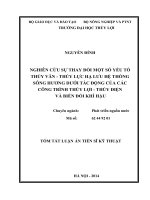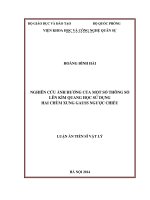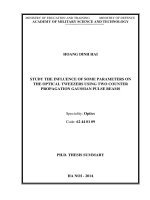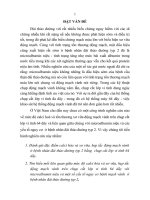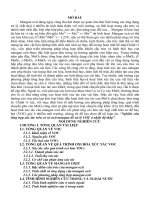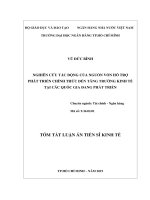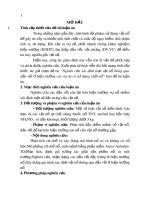tóm tắt luận án tiến sĩ tiếng anh nghiên cứu ảnh hưởng của một số thông số lên kìm quang học sử dụng hai chùm xung gauss ngược chiều
Bạn đang xem bản rút gọn của tài liệu. Xem và tải ngay bản đầy đủ của tài liệu tại đây (2.77 MB, 27 trang )
MINISTRY OF EDUCATION AND TRAINING MINISTRY OF DEFENCE
ACADEMY OF MILITARY SCIENCE AND TECHNOLOGY
HOANG DINH HAI
STUDY THE INFLUENCE OF SOME PARAMETERS ON
THE OPTICAL TWEEZERS USING TWO COUNTER
PROPAGATION GAUSSIAN PULSE BEAMS
Speciality: Optics
Code: 62 44 01 09
PH.D. THESIS SUMMARY
HA NOI - 201
4
TO BEE COMPLETED AT
ACADEMY OF MILITARY SCIENCE AND TECHNOLOGY
MINISTRY OF DEFENCE
Scientific supervisor: Ho Quang Quy. Assoc. Prof. Dr
Reviewer 1: Trinh Dinh Chien. Assoc. Prof. Dr
Hanoi National University
Reviewer 2: Do Quoc Hung. Assoc. Prof. Dr
University of Military Techniques
Reviewer 3: Pham Vu Thinh. Dr
Academy of Military Science and Technology
to be presented and defended the thesis Examining committee of
Academy of Military Science and Technology at h 2014.
The thesis can be found at:
- Library of Academy of Military Science and Technology.
- Vietnam National Library.
1
PREFACE
In 1971, Ashkin has discovered the way in order to balance between
the light pressure and gravity of the dielectric particle of size about 20 µm
[6]. He and his colleagues continue to pursue the field of optical trapping
for small particles with different sizes. His works are mainly interested in
trapping atoms, colloidal particles. They are classified into two categories:
atom cooling by laser and optical trapping. In 1968, Ashkin and his
colleagues published the first result using a beam optical trap to keep the
particles having diameters ranging from 25 nm to 10 µm at a certain point
in water. The device Ashkin used to trap the particles, later called optical
tweezers, and this method is called optical trapping.
The theory of optical trapping mainly calculates the force acting on
particles in different embedding medium. Calculation of the optical force
acting on the particles is directly related to its regime. If particle’s size is
much smaller than the wavelength of the laser light, it is used a Rayleigh
regime , in contrast, optical geometry regime for particle size is larger
than the wavelength of laser light or Mie regime for particle size is
equivalent to the laser wavelength. Many works have been interested in
the effects of tweezers parameters on the optical force. However, the
previous theoretical work on optical forces was only for a plane wave,
which is applied to the laser beam emitted from the cavity plane mirror in
continuous regime. In current practice, the Gaussian laser beam is mainly
emitted from the spherical mirror cavity and modulated pulses. Thus,
many authors have calculated for using “Gaussian” laser tweezers since
2005.
Zhao and colleagues published the results of optical force calculating
for a Gaussian pulse beam. Agree with the first conclusion, M. Kawano
and his colleagues (2008) have proposed an optical tweezers using two
laser beams in the opposite direction and then in 2009 H.Q.Quy and
M.V.Luu have studied the optical force of the two counter-propagating
Gaussian beams. However, an accurate analysis of the stability of the
particles in the trap region and the parameters’ effect on the stability of the
particles are still left open.
In addition, the application of optical tweezers to study living cells
showed that the position of the cell is not completely retained during trap
process, it fluctuates in a certain limit around the trap center. This
indicates the stiffness or the elasticity of optical tweezers have a certain
value. The stiffness is the ratio of the force acting on the particles and the
particle’s fluctuation deviation from its trap center. Therefore, the
2
durability of the trap depends on the force, particle size and embedding
medium conditions.
Hence, it can be stated that the particles trapped in optical tweezers
are unstable but moving in a certain region, and in certain duration.
From the research results of theory and experience mentioned above,
the research of the effect of the optical tweezers parameters on the
stability of the particles is essential. First, it can provide some scientific
conclusions to guide empirical studies by means of simulation, applied for
particle trap.
This is the content mentioned in my thesis "Study on the effect of
some parameters on the optical tweezers using two counter-propagating
Gaussian pulse beams."
The layout of the thesis:
Chapter 1. Overview of optical tweezers using two Gaussian
pulse beams in the opposite direction.
This chapter introduces some concepts of optical force and optical
tweezers’ configuration using two Gaussian pulse beams in the opposite
direction and Brownian motion. Through this analysis a number of factors
affecting the stability of the particles in a fluid under the influence of
optical tweezers using two Gaussian pulse beams in the opposite
direction.
Chapter 2. The dynamic process of particle
This chapter simulated particle’s kinetic process in fluids using
Langevin equation with Brown force and optical force impact. The
analysis of these two forces’s competition in a pulse regime and the
formation of trapping time.
Chapter 3. Effect of parameters on particle's dynamic process
This chapter analyzes the impact of parameters such as initial
position of the particle, the total energy and the beam waist radius,
particle’s radius to its shift speed toward the tweezers’ center as well as its
deviation at the trap center.
Chapter 4. The influence of the parameters on the stable region
This chapter proposed the concept of space - time stability region of
the particle in the optical tweezers. Considered the influence of optical
tweezers parameters, the thermo-mechanic parameters of fluid and particle
on the stability region. Then, we analyzed and selected suitable
parameters for the best space - time stability region.
3
Chapter 1
OVERVIEW OF OPTICAL TWEEZERS USING TWO
GAUSS PULSE BEAMS IN THE OPPOSITE DIRECTION
1.1. Optical force
Photon with the wavelength of λ has a momentum as follows:
ˆ
in in in in
P k k r
= =
ℏ ℏ
(1.1)
When a beam of light enters the medium having refractive index
different from its initial medium, light refraction at the contact surface
between the two mediums, the photon momentum changes its direction,
satisfying the law of momentum conservation (see Figure 1.1). The
change in momentum of the photon is transferred to the particle and on the
particle acts the force, which was called an optical force.
It is usually decomposed into two components: the gradient force and
scattering force.
Figure 1.1. Light rays are
refracted at the interface of
dielectric particles.
Assuming the dielectric particle has a size a smaller than the
wavelength of light (
a
λ
<<
), it can be considered as a dipole interacting
with the light field, the force on the particle is the Lorentz force due to the
effect of electric field gradient as shown in Figure 1.3 The interaction of
light and particle is considered in the Rayleigh regime, the beam has
Gaussian spatial contribution, Lorentz force toward the focal point and is
defined as follows [17]:
(
)
(
)
(
)
(
)
(
)
, , , , . , , , , , ,
P t
grad t
F z t p z t E z t p z t B z t
F F
ρ ρ ρ ρ ρ
= ⋅∇ + ∂ ×
= +
(1.2)
Figure 1.3 Forces on dielectric
particles in the Rayleigh regime.
Using the Rayleigh approximation (ignoring absorption phenomena
and particles as small-spherical microspheres), then we write the gradient
4
force as:
3 2
2
2 1
2
grad
a m
F I
c m
π
−
= ∇
+
(1.10)
where c is the velocity of light in vacuum, and I is the intensity of the laser
beam. Force component scattering along the direction of light propagation
is given by:
2
5 6 2
1
3 2
128 1
3 2
scat
n a m
F I
c m
π
λ
−
=
+
(1.11)
1.2. Optical tweezers use two counter-propagating Gaussian pulse
beams.
1.2.1. Optical configuration of two counter-propagating Gaussian pulse
beams.
Diagram of the optical tweezers’ principle using two Gaussian
beams in a Decard coordinate system is presented in Figure 1.5
Figure 1.5 Diagram of optical traps use two counter-propagation
Gaussian pulse beams:
a. Diagram of two counter-propagation Gaussian pulse beams; b. Plane
of trap center; c. Optical diagram.
1.2.2. Total intensity of two counter-propagating Gaussian pulse
beams.
The electric field of a Gaussian pulse beam [17] can be represented
by the following formula:
( )
[ ]
{ }
( )
( )
( )
[ ]
2
0
0 0
2
0
2
2
2 2
0
2
2
2
0
2
2
2 2
0
W
, , , exp
W 2
2
exp
W 4
W
/
exp exp
W 4
z
ik
E z t d xE i kz t
ik z
kz
i
k z
k
t z c
k z
ρ ω
ρ
ρ
τ
= − −
+
× −
+
−
× − × −
+
(1.12)
where
5
( )
2
0
3/ 2
2
2 0 0
4 2
W
U
E
n c
ε π τ
=
(1.13)
The electric field of a Gaussian pulse beam on the left- hand side is:
( )
( )
( )
( )
( )
( )
( )
( )
( )
2
0
0 0
2
0
2
2
2
2
0
2
2
2 2
0
2
2
2
2
0
W
, , , exp
W 2 / 2 2
2 / 2
exp
W 4 / 2
W
/ 2 /
exp exp
W 4 /2
l z
z
z
ik d
E z t d xE i k z t
ik z d
k z d
i
k z d
k
t z d c
k z d
ρ ω
ρ
ρ
τ
= − + −
+ +
+
× −
+ +
− +
× − × −
+ +
(1.14)
The electric field of a Gaussian pulse beam on the right- hand side is:
( )
( )
( )
( )
( )
( )
( )
( )
( )
2
0
0 0
2
0
2
2
2
2
0
2
2
2 2
0
2
2
2
2
0
W
, , , exp
W 2 / 2 2
2 /2
exp
W 4 / 2
W
/ 2 /
exp exp
W 4 / 2
r z
z
z
ik d
E z t d yE i k z t
ik z d
k z d
i
k z d
k
t z d c
k z d
ρ ω
ρ
ρ
τ
= − − −
+ −
−
× −
+ −
+ −
× − × −
+ −
(1.15)
The corresponding magnetic field in crane approximation can write:
(
)
(
)
2 0
, , , ,
H z t yn cE z t
ρ ε ρ
≅
(1.16)
Pulse intensity or brightness of a light Gaussian pulse beam is a
magnitude’s Poynting vector average over time:
(
)
(
)
(
)
2
22
0
2 2
, , , , , ,
W2
exp exp 2
1 4 1 4
I z t S z t zI z t
zkP
z t
z z c
τ
ρ ρ ρ
ρ
τ
≡ =
= − − −
+ +
ɶ
ɶ
ɶ
ɶ ɶ
(1.17)
The pulse intensity on the right- hand side is:
( ) ( )
( ) ( )
( )
2
2 2
2
2
0
2
, , , , , , exp
1 4 1 4
W
exp 2
z
l z z
t
P
I z t d S z t d z
z d z d
z d k
t
c
ρ
ρ ρ
τ
= = −
+ + + +
+
× − −
ɶ
ɶ ɶ
ɶ ɶ
ɶ
ɶ
ɶ
(1.18)
and the pulse intensity on the left- hand side is:
( )
( ) ( )
( )
2
2 2
2
2
0
2
, , , ( , , , ) exp
1 4 1 4
W
exp 2
z
r z z
t
P
I z t d S z t d z
z d z d
z d k
t
c
ρ
ρ ρ
τ
= = −
+ − + −
−
× − +
ɶ
ɶ ɶ
ɶ ɶ
ɶ
ɶ
ɶ
(1.19)
Considering two completely coherent beams and independent
6
propagating with polarization perpendicular to each other, so the total
intensity of the field
2
l
E
and
2
r
E
can be described by the following
expression:
(
)
(
)
(
)
, , , , , , , , ,
z l z r z
I z t d I z t d I z t d
ρ ρ ρ
= +
(1.20)
1.2.3. The influence of the distance d to the total intensity distribution
As we have analyzed in the optical configuration of two Gaussian
pulses in the opposite direction, from the formula (1.18), (1.19) and (1.20)
the distance between the two beam waists of the beam is one of the
parameters affect the total intensity of the beams. Especially this parameter
greatly affects the intensity distribution in the overlapping area, the region
has a significant influence on trapping efficiency. Therefore, examining the
influence of this parameter on the overall intensity is very important.
a b c d
Figure 1.7. Total intensity distribution with different values of the
distance d between the two beam waists: 15 µm (a), 10 µ m (b),
5 µ m (c) and 0 µm (d).
1.2.4. The influence of the beam waist W
0
on the total intensity
distribution
a b c d
Figure 1.8. Total intensity distribution with different values of waist radius
W
0
side: 2 µm (a), 1.5 µm (b), 1 µm (c) and 0.5 µm (d).
1.2.5. Optical forces on dielectric particles
Scattering force:
( ) ( ) ( )
2 2
, , , , , , , , ,
scat pr l pr r
n n
F z t d z C I z t d z C I z t d
c c
ρ ρ ρ
= −
(1.21)
The force with gradient radial coordinates:
( )
(
)
( )
(
)
( )
,
2 2
2 0 0 2 0 0
2 , , , 2 , , ,
, , ,
W 1 4 W 1 4
l r
grad
I z t d I z t d
F z t d
cn z d cn z d
ρ
σ ρ ρ σ ρ ρ
ρ ρ ρ
ε ε
= − −
+ + + −
ɶ ɶ
ɶ ɶ
ɶ ɶ
(1.22)
7
The force follow the propagation axis:
( )
( )
( ) ( )
(
)
( )
( )
( )
( )
( ) ( )
( )
( )
( )
2
2
2 4
2
0
0
,
2
2 2 2
2
2 0 0
2
2
2 4
2
0
0
2 2 2
2
2 0 0
2 1 4 2
W
2 , , ,
W
W
1 4
2 1 4 2
W
2 , , ,
W
W
1 4
l
grad z
r
z d z d
z d k
I z t d
kt
F z
n ck c c
z d
z d z d
z d k
I z t d
kt
z
n ck c c
z d
ρ
σ ρ
ε τ τ
ρ
σ ρ
ε τ τ
+ + + −
+
= − − +
+ +
− + − −
−
+ − +
+ −
ɶ ɶ
ɶ
ɶ
ɶ ɶ
ɶ
ɶ
ɶ
ɶ
ɶ ɶ
ɶ
ɶ
ɶ ɶ
ɶ
ɶ
ɶ
ɶ
(1.23)
1.2.6. Influence of waist radius W
0
on the vertical optical force
distribution
If particle is located between two trap boundary regions, it will
oscillate freely (thermal motion), meaning that the optical force components
have no role in trapping dielectric particles. Under the rising direction of the
beam waist radius, the magnitude of the trap region will increases gradually,
but the maximum value of the optical power decreases with the results
presented above (Figure 1.9),
Figure 1.9. Optical power distribution along the phase plane (z, t) for different
values of waist radius W
0
: 0,5
µm
(a); 1
µm
(b); 1.5
µm
(c) and 2
µm
(d).
1.2.7. Effect of pulse width
τ
ττ
τ
on the distribution of vertical optical force
8
Figure 1:10. Longitudinal distribution of optical force in the phase plane (z,
t) for different values of the pulse widths τ: 0,5ps (a); 1ps (b); 1,5ps (c) and
2ps (d)
1.2.8. The influence of the distance of two beam waists d to the
longitudinal optical force.
Figure 1:11. The distance’s influence d to the longitudinal distribution of
optical force: d = 5 µm (a), d = 10 µm (b), d = 15 µm (c), d = 20 µm (d).
1.2.9. Influence of waist radius W
0
to the transverse optical force
9
Figure 1.12. Transverse optical distribution in plane phase (ρ,t) for values
of W
0
: 0,5 µm (a); 1 µm (b); 1,5 µm (c) and 2 µm (d).
Transverse optical force creates a potential hole as shown in Figure
1.13. All the particles fall into the potential hole always tend to be
attracted to the bottom, which is being pushed into the center of the
optical tweezers. The potential hole’s height is the maximum value of the
transverse force. The maximum value of the transverse force changing
with the beam waist radius is presented in Figure 1.14.
x
y
Figure 1.13. Potential hole that
created by a transeverse force.
Figure 1.14. Optical trnasverse forces
depend on beam waist radii: t=1τ,
d=10µm at the position z = 0µm.
1.2.10. The influence of the distance of two beam waists d to transverse
optical force
Figure 1.15. Distribution of transverse optical force F
grad
in the plane (ρ,t)
for different values of d: 1 µm (a), 5 µm (b), 10 µm (c) and 15 µm (d).
10
1.2.11. The influence of pulse width on the transverse optical force
Figure 1.16. Transverse optical force, F
grad
in phase plane (ρ,t) for
different pulse widths of τ: 0,5 ps (a); 1ps (b) and 1,5 ps (c).
1.3. Brownian motion of dielectric particles in fluid
The particles move in orbits like as figure 1.17 is defined as a
Brown particle.
Figure 1.17. Brownian
motion model
Full equation describes the motion of particles in fluid:
. 2. . . ( ) . .
N
dv
m v F D h t m g k r
dt
α α
= − + + + +
(1.31)
1.4. Factors affecting the stability of optical trap
1.4.1. The requirement of stability
We know that in order to study the characteristics and properties of a
dielectric particle in fluid or a cold atom in a cold chamber (cryotrap)
must be positioned it in a given area (stable region as small as possible) .
The particle’s stability is not only in space (stability in a given space) but
in time (stability in a desired time duration).
11
1.4.2. Factors affecting the stability of the particle in the trap process.
- The energy of the laser
beam;
- Laser pulse duration;
- The laser beam waist (spatial
distribution of the laser beam);
- The gap between the two waist sides.
- Characteristics of the particle (size,
refractive index).
- Characteristics of the fluid (viscosity,
refractive index, temperature).
1.5. Conclusion
In this chapter , some basic knowledge such as optical force, optical
tweezers configuration uses two beams in the opposite direction, the effect
of optical parameters on the distribution of optical force, Brownian motion
and a number of factors affect the stability of optical tweezers were
presented .
Optical force is the light pressure acting on the material, however, it
is weak for the incoherent light.
Laser beam is coherent, orientation, the average power (E=1µJ) may
also impact on the particle with a force of about 0,01÷30 pN, equivalent to
the interaction between macromolecules in DNA sequence, depending on
the numerical aperture of the objective system.
Due to those forces, laser beams having intensity gradient will pull
particle in areas with high intensity when embedded in a smaller refractive
index medium and drag it in low-intensity regions when embedded in
larger refractive index medium (optical gradient force ) and push it in the
direction of particle propagation (optical scattering force). Optical system
uses a focused laser beam (generated gradient magnitude ) to keep particle
embedded in a fluid called optical tweezers.
Optical force acting on the particles are three different regimes
depending on the ratio between the laser wavelength
λ
and particle radius
a (assume that particles have microspheric shape). Geometry regime is
applied for
a
λ
>>
, Rayleigh regime
a
λ
<<
and the Mie one
a
λ
∼
Optical tweezers used two counter-propagating Gaussian pulse
beams having polarization to be perpendicular each other to enhance the
optical force and avoid scattering forces. In this optical tweezers, the
intensity of the laser is the sum of two beams and optical force acting on
the particle generated from this total intensity. Therefore, the value and
distribution of optical force in time-space depends on the structure
parameters of tweezers such as beam energy, beam waist radius, the
distance within beam waists, pulse width ,etc In addition, the optical
force depends on the particle radius, viscosity of the fluid.
These parameters not only directly affect on the optical force and its
distribution but also affects the dynamics of particles in the fluid and the
stability of tweezers (or the stability of the particle in space - time ).
12
The dynamic process of particles in fluid will be Brownian motion if
having no external field effect. In optical tweezers, the particle is affected
by Brownian force and optical force control (considered as external
forces), therefore, the dynamics of particles is described by the Langevin
equation with the effect of the two forces said above. Dynamics of
particles in a fluid under the action of optical forces will determine the
stability of optical tweezers.
Chapter 2
DYNAMIC PROCESS OF PARTICLE
2.1. Lagevin equation for the general case
To study the motion of particles in fluid, we start from the classical
Newton's second law [24].
d
m f
dt
υ
=
(2.1)
in which ,
totalvis
fff
+=
(2.2)
We get the full equation describing the motion of particles in fluid as
follows:
.
N Brown gravity Hydrate
d
m F f f f
dt
υ
α υ
= − + + + +
(2.8)
. 2. . . ( ) . .
N
dv
m v F D h t m g k r
dt
α α
⇔ = − + + + +
(2.9)
2.2. Dynamic equation of particle in optical trap using two counter-
propagating pulsed Gaussian beams
Equations of motion of the particles is reduced as follows:
2D ( )
opt
dv
m v F h t kr
dt
α α
= − + + +
(2.10)
Optical force acting on the particle consists of two forces, the gradient
force (
rad
g
F
) and scattering force (
scat
F
), showed below
rad rad, rad,z rad,
opt g scat g g scat g z
F F F F F F F F
ρ ρ
= + = + + = +
(2.11)
To examine the effect of these factors, we select the simulation of
the motion of particles, from which we consider meaning of physical
phenomena. Simulation algorithm will be introduced in the following
section.
2.3. Algorithm and simulation procedure
We study two-dimensional motion (in the plane) and the position of
the glass particle in water by means of Brownian kinetic method. Fluid
sample is used to describe the motion of particle and therefore, the
13
following equations of motion for each particle is calculated on the focal
plane [17], [24]:
rad,
( ( ))
( ) ( ) 2. . . ( )
g
F t
t t t t D t h t
ρ
ρ
ρ δ ρ δ δ
α
+ − = +
(2.18)
At the moment
0
0
=t
, we assumed that the particle are located at
0
)0(
ρρ
=
, optical force
),0(
0,
ρ
ρ
FF
grad
=
. Using (2.18) we found the position
of the particle in the trap
(
)
tt
δ
ρ
ρ
+
=
0)(
1
, which is calculated
δρ
after
the period
t
δ
. Then, instead of
)(
1
t
ρ
and
1
t
into the formula (2.13)÷(2.15)
we calculate the optical force
(
)
),(
11,
ttFF
grad
ρ
ρ
=
. This process continues
until the moment
τ
6=
n
t
. Using Matlab program, simulation has been
carried out. The dynamic process of particle in the tweezers was simulated
through orbital motion of particle in the pulse duration and the effect of
the laser beam parameters, fluid environment to orbit and orbital speed
changes.
2.4. Brown motion in the focal plane
a b c d
Figure 2.1. Brownian motion of glass particle in the water from a beam
axis around ρ
0
= 1(µm) with different simulation time steps:
a)
6 / 2000
t
δ τ
=
,b)
6 / 4000
t
δ τ
=
,c)
6 / 8000
t
δ τ
=
, d)
6 / 10000
t
δ τ
=
.
However, the motion shape and different random.simulation time steps
a b c d
Figure 2.2. Brownian motion of glass particle in the water from a beam
axis around ρ
0
= 0 (µm) with simulation time steps:
a)
6 / 2000
t
δ τ
=
, b)
6 / 4000
t
δ τ
=
, c)
6 / 8000
t
δ τ
=
, d)
6 / 10000
t
δ τ
=
.
14
2.5. The dynamic process of particle with optical force
Figure 2.3. The position of the
particle in the trap
Figure 2.4. The particle’s position
on the surface of the speciment.
After moving to trap center, particle is trapped. Although the Brown
force still acting on the particle but can’t overcome the optical force. The
gradient force has the symmetry through the center so particle will be
pushed back and forth, oscillation is relative to the trap center, in this
period we can see the stationary particle or to be stable in the neighboring
region of trap center (zone 3). The stability process is prolonged in the
time interval from t = 1,6 (ps) to the neighboring time t = 4,4 (ps) [30].
Figure 2.5. The position of the
particle in the trap corresponds
to the parameters:
U=0,5.10
-6
(J) τ=1(ps), a=10(nm),
λ=1,064 (µm), ρ
0
= 0(m),
W
0
=1(µm), t=(1,6÷ 4,4) ps.
2.6 Conclusion
When is not under optical force, the motion procedure of a particle is
random by Brown forces.
The optical tweezers using two counter-propagation Gaussian pulse
beams with the given parameters, a glass (bead size a = 10nm, the
refractive index is n
1
= 1,592 is dipped in water n
2
= 1,332 in a pulse
duration and the viscosity
η
=7,797x10
-4
Pa.s, at room temperature
T=25
0
C) have certain dynamical process, have stable oscillation period
(period 2τ) and also having random period.
This process varies depending on the different conditions through the
values of the input parameters.
+ Under the impact of optical force, small particle oscillates slightly
in a stable region of space - time (Figure 2.5). Stability radius is about the
radius of particles (~ a), and stability time of the particle at around 2τ. In
the sample above, the half pulse width is 1ps. However, in experiment, the
15
pulse width can be longer extension with condition must increase the ratio
of energy and reduce the ratio of incident laser beam waist radius so that
power is invariant.
We have examined the dynamics of the particle with a few different
values of energy and the initial positions of particle aimed at analyzing the
competition between optical and Brownian forces. It is clearly showed
that dynamics of particle depends significantly on the other parameters. In
Chapter 3, we will consider a more specific way to see the effect of these
parameters on the kinetic of particle and carry out operating conditions of
optical tweezers using two Gaussian pulses in the opposite direction.
Chapter 3
INFLUENCE OF PARAMETERS
ON PARTICLE’S DYNAMIC PROCESS
3.1. The influence of particle’s initial position
a b c d
Figure 3.1 The position of particle in the trap corresponds to parameters
U=0,5.10
-6
(J). ρ
0
= 2(µm)(a); ρ
0
= -2(µm)(b); ρ
0
= 1(µm)(c); ρ
0
=-1(µm)(d).
So the process of particle dynamics for different initial position is
only different in early stages when pulse intensity is small, the pulse
intensity is larger (regional stability) dynamical process is unchanged.
However this is not true for other values of energy, particle size as
well as pulse width. To see this clearly we investigated the value of the
pulse energy U=0,1.10
-6
J smaller above case, the dynamical process of
particle simulations corresponding to different initial positions clearly see
in Figure 3.2.
a b c d
Figure 3.2 The position of particle in the trap corresponds to parameters
U=0,1.10
-6
(J). ρ
0
= 1(µm)(a); ρ
0
= 2(µm)(b); ρ
0
= 3(µm)(c); ρ
0
= 4(µm)(d).
16
3.2. Effect of total energy
a b c
Figure 3.4 The position of particle in the trap corresponds to parameters
U: 0,01(µJ)(a); 0,1(µJ)(b); 0,2(µJ)(c)
3.3. Effect of beam waist radius
a b c d
Figure 3.5. The dynamical process of particle in the trap with parameters
W
0
=1(µm)(a); W
0
=2(µm)(b); W
0
=3(µm)(c); W
0
=4(µm)(d).
When the beam waist radius increases, while the total energy does
not change, so the peak intensity will decrease (see formula 2.16).
Increasing the radius of the beam waist at the same time reducing the peak
intensity gradient resulting in reduced intensity. Results in the optical
gradient force decreases rapidly and hard particle is pulled towards the
trap center position.
3.4. Effect of particle size
a b c d
Figure 3.6. The dynamical process of particle in the trap with parameters
a= 8(nm)(a); a= 10(nm)(b); a= 14(nm)(c); a= 18(nm)(d).
Simulation results showed that the particle has different radii will
have different dynamical processes. The larger particles tend to move
17
faster toward tweezers’ center and stability is longer at that position, the
small particles, in contrast, their mobility is greater.
3.5. Conclusion
Before using optical tweezers, it is necessary to put particles into
the trap region because the particles far away from the center of the laser
beam traps need large energy and large beam waist radius (which will
reduce the intensity gradient). Ideally, the farthest distance between
particle and center is equal to beam waist radius, at which the optical force
had impacted on.
To trap particles of radius of a = 10 nm, it is put in fluid with
viscosity
η
=7,797x10
-4
Pa.s at room temperature T=25
0
C, had lower
refractive index n
2
=1,332 (compared to the refractive index of particle
n
1
=1,592), optical tweezers need to use two Gaussian laser pulses having
total energy U > 0,1µJ and waist radius W
0
=1 µm.
If the used laser beam has a larger total energy, for example,
U=0,9µJ, its waist radius must be less than 4µm, the best value is
W
0
=1µm. If the beam waist radius W
0
> 4µm, optical tweezers will not
trap the particle on.
Optical tweezers using above laser beam (U=0,9µJ, W
0
=1µm) will be
more effective if the particulate trap size is greater than or equal to 10nm,
within the Rayleigh limit (a<< λ). Optical tweezers play a role on the
stability of large-sized particles.
The higher the energy, the smaller the beam waist radius and
particle radius becomes larger, longer-lived particles in the tweezers
center. The existance duration of particles and the region’s size
surrounding the tweezers center (after we will define a stable time-space
region) depends on the parameters examined and other related parameters.
These issues will be studied and presented in Chapter 4 below.
Chapter 4
INFLUENCE OF PARAMETERS
ON TWEEZERS’ STABILITY REGION
4.1. The concept of the stable space - time region
The results in Chapter 3 also showed that the particle’s stability
region is not absolutely stable that fluctuate a limited area adjacent to the
radius trap center with the radius
ρ
∆
, in a period of time
t
∆
. I said: "
particle is stable in the space - time cylinder" or tweezers have defined
space - time stability region (Figure 1.4). In fact, the better stability of
particles as
ρ
∆
smaller and
t
∆
larger.
18
Figure 4.1. The optical tweezers’
stable region
Figure 4.2. The limit of particle’s
stable region on the plane x-y.
Stable time is defined as follows:
out in
t t t
∆ = −
(4.1)
The value of the stable diameter averaged by simulation steps in
stable intervals ∆t and is defined as follows [31]:
2 2
out in
i i
i i
t tt
t t
ρ ρ ρ
−
∆
∆ = =
∂ ∂
∑ ∑
(4.2)
By the simulation steps as in Chapter 2 and 3, we determined the
above value of
t
∆
and
ρ
∆
with the changed input parameters.
4.2. The influence of the laser pulse energy on stable region.
Figure 4.3. The dependence of
stability time on laser energy.
Figure 4.4. The dependence of
stability diameter on the laser
energy.
4.3. Influence of the beam waist radius on stable area
Figure 4.5. Dependence of stability
time on the beam waist radius.
Figure 4.6. The stability
diameter’s dependence on the
beam waist radius.
19
4.4. Effect of pulse width on the stable area
Figure 4.7. The dependence of the
stability time on the Gaussian pulse
width.
Figure 4.8. The dependence of the
stability diameter on the Gaussian
pulse width.
4.5. Effect of pulse repetition frequency on stable area
Figure 4.9. Stability of the particles
depends on pulse repetition
frequency
1
6.
f
τ
= .
Figure 4.10. Stability of the
particles depends on pulse
repetition frequency
1
4.
f
τ
= .
Figure 4.11. Stability of the
particles depends on pulse repetition
frequency
1
3.
f
τ
= .
Figure 4.12. Stability of the
particles depends on pulse
repetition frequency
1
2.
f
τ
= .
So, instead of using large energy continuous laser, we can use the
lower-energy laser pulses but with high repetition frequency also create
good stable region.
4.6. The impact of pulse delay on the stable area
In fact when making optical trap using two Gaussian pulses in the
opposite direction can’t usually eliminate all objectivity incorrect such as:
The selection of the optical system, the optical path of two Gaussian pulse
beams to the target .etc , leading to the phase difference between two
pulses (delay between two pulses). Therefore, the effect of time delay on
the stable area is very important.
20
a b
Figure 4.13. The impact of pulse delay on the steady area when δT = 0.
a. Kinetic simulation of particle;
b. Right pulse intensity (1), left (2) and total pulse (3)
The result shows that, when there is no pulse delay or two pulses
transmitted to the trap center (where n = 0) have no phase difference,
result in the total intensity is enhanced and thus the stable diameter is
nearly equal to the particle’s radius. Stable time is equal to the pulse width
(Figure 4.13).
a b
Figure 4.14. The impact of pulse delay on the stable area when δT= 1τ.
a. Kinetic simulation of particle;
b. Right pulse intensity (1), left (2) and total pulse (3)
a b
Figure 4.15. The impact of pulse delay on the stable area when δT= 2τ.
a. Kinetic simulation of particle;
b. Right pulse intensity (1), left (2) and total pulse (3)
When the delay increase δT=3τ, the stability of particle is not continuous
any more, it is divided into two areas, between Brownian area (figure
4.16).
21
a b
Figure 4.16. The impact of pulse delay on the stalbe area when δT= 3τ.
a. Kinetic simulation of particle;
b. Right pulse intensity (1), left (2) and total pulse (3)
In case n = 4, the instability phenomenon is more obvious (Figure
4.17) and optical trap become a single pulse one and consider for the
trapping process of two consecutive pulses.
a b
Figure 4.17. The impact of pulse delay on the stable area when δT= 4τ.
a. Kinetic simulation of particle;
b. Right pulse intensity (1), left (2) and total pulse (3)
From the simulation above results indicate that the enable delay of the two
pulses
2
T
δ τ
<
can generate stable region of trap.
4.7. Effect of particle radius on the stable region
Figure 4.18. The dependence of the
stable time on the particle radius.
Figure 4.19. The dependence of
the stability diameter on particle
radius.
From the simulation result we found that particle has greater stability
with a large particle radius.
22
4.8. Effect of fluid viscosity on the stable area
The refractive index of the fluid at a temperature of 20°C is
calculated by the following semi-empirical formula [1]:
( )
2
2
5 6
4
0 1 2 3 7
2 2 2 2 2
2
1
1 /
2
UV IR
a a
an
a a a T a T a
n
ρ ρ λ ρ
λ λ λ λ λ
−
= + + + + + + +
+
− −
(4.3)
Bảng 4.1. The viscosity of fluid [1].
TT
Fluid Viscosity
η
[mPa.s]
1 Alcohol methyl 0,59
2 Water 1,00
3 Alcohol ethyl 1,1
4 Alcohol ethyl 2,4
Using the viscosity and the refractive index of the fluid in table 4.1,
the impact of stable time and diameter on viscosity is described in Figure
4.20 and 4.21 [29], [30].
Figure 4.20. Dependence of the
stable time on the fluid viscosity.
Figure 4.21. Dependence of the
stable diameter on the fluid
viscosity.
From two above figures we have two remarks that: When the fluid
increases, the stability of the particles also increases. This easily explains
follow: when the viscosity increases leading to mobility reduction of
particles and therefore, more stable particle.
In addition to the above parameters, the parameters such as laser
wavelength, fluid temperature, refractive index also impact on the
stability of the particles. However, we can use analogy based on
relationships between the parameters to take into account this effect. For
example, through the expression of the total energy U and the beam waist
radius W
0
can deduce the wavelength of the laser, or using the expression
of diffusion coefficient D can obtain temperature. Since then, we can
deduce the effect of these parameters on the stability of the particle.
4.9. Conclusion
In this chapter we have investigated the effect of the optical
parameters as well as thermo-mechanics on the space - time stable region.
Through the simulation results for each specific case, we can confirm the
23
optical parameters and mechanics have certain influence to the stability of
the particle.
- The stability increase in the use of higher laser energy;
- Pulse width and beam waist radius affect the stable area of the
particle. The increase or decrease of quantities must depend on the actual
needs of the alternatives: increase stable time or reduce stable diameter.
Reducing the pulse width (energy unchanging) the stability of the particle
will increase, but the stable time will be short. Increased pulse width with
increasing energy and stable time will increase. Beam waist radius
increases, the stable area will increase but stability will decrease, shorter
beam waist radius higher stability, but the stable space area will be
narrower. In this case, only a small oscillation would also lose the
particle’s stability (particle will leave the stable area).
- Time stability of large particle using high pulse repetition
frequency however, can use high power laser and the appropriate
frequency, the particle could also be stable in the necessary duration.
- The design of optical tweezers need to pay attention to the phase
difference between the two laser sources because the time delay between
the two sources affects to the stable time of the particle, the time delay
δT> 2τ, the trap is no longer stable area.
- From the results of the studied sample, using the theoretical
expression and simulation methods, we can expand to simulate the other
cases. In each case we can choose the optimal related parameters.
SUMMARY
From the Langevin equation describing Brownian motion of particles
in fluids has led to derive equations describing the motion of particles
under the influence of the optical forces when it is laid in optical tweezers.
With reasonable assumptions for the sample particles in specific medium,
simulation procedure has been proposed and examined the dynamics of
particles in a fluid in the absence of optical force as well the appearance of
optical forces with different optical and mechanical parameters. The
results for the motion of particles in a fluid under the action of laser
pulses, thus, confirm the competition of optical force and Brownian force
during the laser pulse duration.
From the examination of the impact the original position, total
energy, beam waist radius and the radius of the particles on the dynamics
of particles in a fluid environment. It has been confirmed:
To trap a particle size a = 10 nm, it is embedded in fluid with
viscosity
η
=7,797x10
-4
Pa.s, at room temperature T = 25
0
C, refractive
index ratio between the particle and the water will be
m=n
1
/n
2
=1,592/1,33, must use two Gaussian laser pulses having the total
